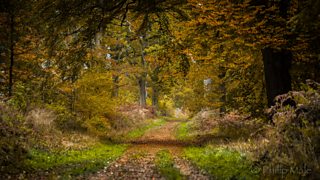
Photo credit: Philip Male (Flickr)
1) Guess who's back...back again!
We're back and we're excited to share with you all a few little snippets about what'll be featuring in Autumnwatch 2017. We're heading back to our Springwatch home, at the in the heart of the Cotswolds.
Chris, Michaela, Martin and Gillian will be sharing with us some new and exciting stories and we will be revisiting that we got to know and love on Springwatch.
2) A foxy frenzy: urban vs rural
Gillian Burke is heading to the South Coast of England on a quest to find out more about our urban foxes, and to investigate how they match up to their rural rivals.
Autumnwatch will also look into how their contrasting environments make them behave in different ways, putting their scavenging skills to the test.
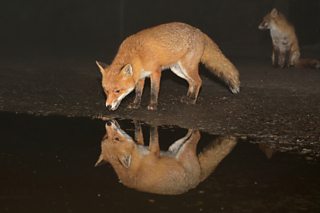
Photo: Full Moon Images
3) Catch up with some of our familiar faces from Springwatch - and meet some new ones too!
During Autumnwatch, we'll catch up with some familiar faces during our time back at Sherborne Park Estate and we'll get a chance to meet some new faces, too!
Not all of us disappeared straight after our last series of Springwatch...some stuck around to see exactly how what our young'uns got up to and whether they managed to fledge or fail. As the kestrels grew in size, the room inside their nest was slowly shrinking, so the risk of a premature fledge was potentially on the cards.
For our barn owl family, there was a clear size difference between the bigger chick and the smaller, and although this is normal to find within owl clutches, we were uncertain as to whether the little chick would pull through.
Amazingly, back in spring, we managed to introduce an adopted peregrine falcon chick into a nest at Salisbury cathedral. We were over the moon to find that both parents and it's newly adopted brother welcomed him into the family, but how exactly did they fare over the summer- did they fledge successfully?
As for the kite family, fledging was imminent with some epic wing flapping and branching observed close to the end of the series, we were sure that they were ready to depart at any time! Our cameramen stuck with the nest to bring us new developments with this family of kites.
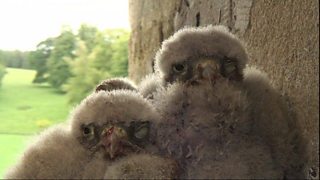
Smile for the camera! Our kestrels looking as beautiful as ever.
4) Wonderfully teeny tiny...the harvest mouse
Follow us as we delve into the little micro-world of the harvest mouse - exploring and unearthing new and exciting footage of this elusive little rodent.
The harvest mouse is the smallest rodent in Europe, weighing a measly 4-6 grams. They can be identified by their blunt nose, round, furry ears and golden-brown fur. Incredibly, they are the only British mammal to possess a prehensile tail, which acts as a 5th limb!
These tiny little rodents are fantastic climbers; the female constructs her very complex, tightly woven nest up to 1 metre from the ground within grasses and reeds. After the female has given birth and raised her young, at just 18 days she decides enough is enough and kicks her young out, sometimes even displaying aggression against them. At just six weeks the young are ready to breed and the cycle starts all over again.
Harvest mice rarely live beyond 6 months, as adverse weather conditions and predation is their main killer, however they have been known to live up to 18 months. They inhabit southern parts of England and coastal areas of Wales, however there are some small scattered populations across the UK.
Be sure not to miss out as we take a peek into the life of this incredible little mouse!
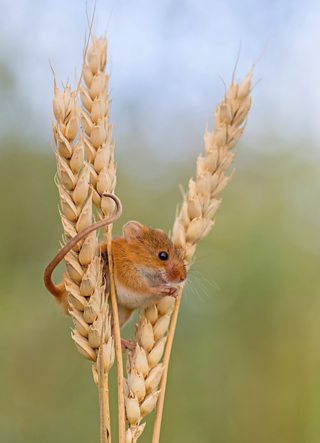
Photo Credit: Jefflack Wildlife & Nature (Flickr)
5) Micro-plastics are causing mega-destruction
Autumnwatch follows Raymond as he uncovers some of the shocking statistics associated with plastics in our oceans and the effect it is having on the fulmar.
We all know the toll plastics have on our oceans. Micro-plastics found in cosmetics were banned by the UK government earlier this year, but there's still so much more to do. Recently working off Kent's coast revealed that they had found plastics in 80% of mussels they tested. It's safe to say; the damage plastic does to our environment and the life that lives in it is increasing at an alarming rate.
During Autumnwatch we'll explore how plastics are having a devastating effect on British wildlife. For one wildlife cameraman, the toll plastics are having on our sea birds is too much to bear. The fulmar has a special place in the heart of Raymond Besant; it's the first bird he learnt about whilst growing up in Orkney.

Photo Credit: Ann Millen (Flickr)
6) Swan vs goose: an epic battle off...Top Gun style!
Cue the smoke machines, shoulder pads and bad hair. Chris and Martin are back - and in true 80's style!
We've pitched a whooper swan against a greylag goose; the ultimate battle in this Top Gun style showdown and only one can be the winner! Let's look at their credentials...
The whooper swan (Cygnus cygnus)
- Average wingspan: 2-2.4 metres, length: 1.4-1.6 metres
- Average weight: 9-11kg
- These are winter visitors, making their way from their summer breeding grounds in Iceland and other parts of Scandinavia.
- They fly in large flocks, sometimes up to 1,000 individuals and are ranked 4th among all birds by flight height at a 'whooping' 8,200 metres!
The greylag goose (Anser anser)
- Average wingspan: 1.5-1.7 metres, length: 74-84cm
- Average weight: 3.3-3.8kg
- Greylag geese range across much of Europe and Asia, breeding in the Scandinavian regions and extending as far as the Black Sea, between Ukraine and Turkey.
- Although whooper swans are much larger in comparison, greylag geese are known to be the bulkiest of all wild geese native to the UK and Europe.
So, will the smaller of our competitors, the greylag goose be the most agile and outcompete its larger nemesis...or will the whopping whooper extend far past it's laggy rival?
What do you think will be the 'Anser'?
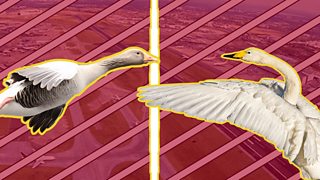
The whooper swan vs the greylag goose..an epic battle off..Top Gun style!

7) Inspired by trees
Most of us are aware of what the positive effects of being outdoors and in nature can be; a feeling of freedom, relaxation, peace, tranquility and escapism. We can switch off from our hectic lives and focus on being 'in the moment', heightening our senses to the sounds, smells, shapes and colours all around us. Whatever time of year, you'll be sure that each time you experience nature, it is always different, always has something new to bring you, never judges and is always there for you.
Now that we've moved through two of the four seasons, we can look forward to the season of autumn. A cosy, comforting season to many, where the robin changes it's song, the smell of the woodland evolves from fresh leafy green to decaying malty brown and the fresh feeling that the cool blanket of mist brings us.
Each person experiences nature in different ways: some focus on the intricacy of each tiny organism that is woven into every little ecosystem, some look at nature from a distance and appreciate from afar whilst others like to be 'in' nature- taking time to lap up every offering the outdoors gives us...even if it is pouring with rain.
No matter how you choose to experience nature, we all know of the positive effects it has on us and for some, the feeling of being outside in nature provides an instant relief, that I'm sure many of us have felt.
In a film, which we're particularly excited to share with, we hear the incredible story behind a man, Marchant, who uses the characters of the trees and feelings of being among them as a sanctuary. He uses the library of trees at Westonbirt Arboretum to inspire his words through poetry, which is displayed for all to see. Marchant believes that if people start seeing the trees differently through his poetry, then his words have worked.
"If I write, I am. If I write, I can be. If I write, I am seen"

Photo Credit: vinothgurusamy (Flickr)
